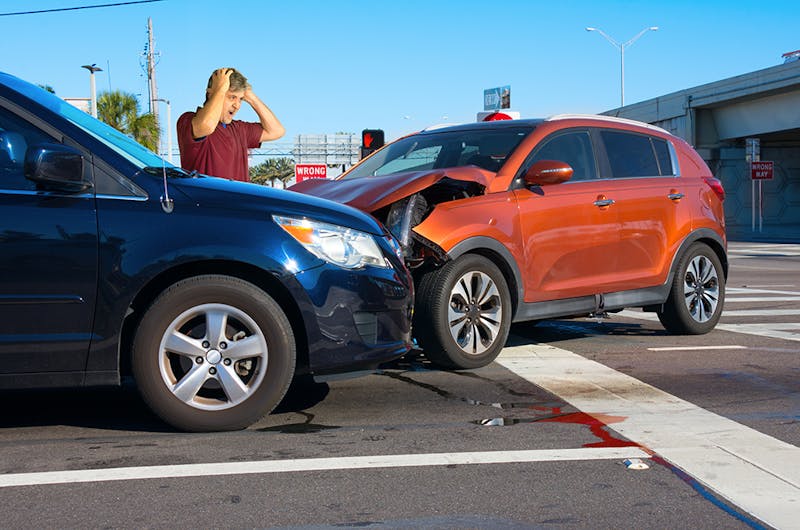
Wrong-way accidents are relatively rare compared to other types of accidents—like rear-end collisions, T-bone crashes, or blind spot accidents. Wrong-way collisions are estimated to comprise roughly 1% of motor vehicle fatalities—about 300-400 deaths a year.
When a wrong-way accident does occur, the outcome is usually quite severe. A wrong-way collision is typically a head-on collision or a high-speed sideswipe. This involves two vehicles driving directly toward one another prior to impact. The force of collision often leaves drivers and passengers with catastrophic injuries. Many wrong-way accidents are fatal to vehicle occupants, especially those in the front seat.
How Do Wrong-Way Accidents Happen?
The state of Arkansas recognizes wrong-way driving accidents as a serious problem. In 2018, a $3 million investment was made to upgrade markings and signs at all interstate exit ramps. This targeted action aimed to decrease the likelihood that a driver could mistakenly take the wrong ramp entering or exiting a highway.
The Arkansas Department of Transportation has pledged to make further efforts—such as the use of internal flashing signs and thermal cameras to detect wrong-way driver movement—in order to reduce the rate of wrong-way fatalities in our state.
What causes wrong-way accidents? In simplest terms, wrong-way accidents happen when a driver operates their vehicle in the wrong direction on a road or highway. This type of accident often involves drunk driving. An intoxicated driver may lack the capacity to read road signs or notice the movement of other vehicles.
The following scenarios may lead to a wrong-way accident:
- A driver enters a highway using an exit ramp
- A driver exits a highway using an on-ramp
- A driver operates a vehicle in the wrong direction down a one-way street
- A driver makes a turn at an intersection that leads to a one-way street
- A driver using unfamiliar roads isn’t aware of the direction of traffic
- A driver fails to notice detour signs and continues on a one-way roadway
- A driver unfamiliar with local traffic laws drives on the wrong side of the road
- An intoxicated, distracted, or otherwise impaired driver drifts into the opposite lane
- An unmarked road with insufficient signage doesn’t alert drivers to one-way rules
- A mechanical malfunction causes a vehicle to veer into the wrong lane
- A poorly-designed road or exit makes it easy for a driver to travel in the wrong direction
- An elderly driver (who may be experiencing cognitive or visual impairment) drives into coming traffic
How To Avoid Wrong-Way Driving Accidents
There are a few practical tips drivers can implement to minimize the risk of a wrong-way collision. The most important element is attentiveness. A distracted driver whose eyes, mind, and hands are focused on other activities is more likely to cause a wrong-way driving accident—and less likely to see a wrong-way driver with enough time to avert a crash.
Next time you’re driving, keep in mind the following tips to avoid a wrong-way collision:
- Continually scan the road ahead for signs of a vehicle traveling in the wrong direction. It’s recommended that you keep at least one city block or one-quarter mile on the highway in your sight and attention.
- Remain especially focused when navigating on-ramps and off-ramps. Be aware of the possibility that another driver may exit or enter the highway via the wrong ramp, especially at night. Be prepared to react if a vehicle comes suddenly toward you.
- Never drive distracted. If your eyes, hands, and mind are on a cell phone screen—instead of on the road in front of you—your abilities to react to an approaching vehicle (or any other obstacle) are severely impaired. To improve your odds of avoiding a wrong-way collision, make sure that you are not compromising your safe driving skills.
- Whenever possible, keep your vehicle in the right lane of the highway. In the U.S., drivers traveling in the wrong direction often stay to the right of the roadway as they would when driving in the correct direction. You’re more likely to be struck by a wrong-way driver when traveling in the left lane.
- Whether you’re driving on familiar or unfamiliar roads, pay attention to street signs. It can be easy to ignore signs in the city or town where you drive every day. But wrong-way accidents sometimes occur when a street sign changes or traffic is redirected due to construction, an accident, or another road obstruction. Make sure that you are aware of any altered or temporary traffic patterns.
- Don’t be the cause of a wrong-way driving crash. Never drive intoxicated. Drunk driving is one of the top causes of this type of dangerous motor vehicle collision. When drivers get behind the wheel drunk or under the influence of drugs (even if it’s a prescribed medication), they endanger their own lives and the lives of others.
Legal Guidance Following a Wrong-Way Crash
Being involved in a collision you didn’t cause is extremely challenging. When you know you did everything you could to drive safely—yet were still involved in a devastating car accident—it can be even more difficult to face the consequences. Expensive medical bills, pain and suffering, missed work and lost wages, permanent disability—it’s not right that you should bear sole responsibility for these enormous physical, emotional, and financial repercussions caused by another party’s wrongful actions.
Contact McMath Woods P.A. to learn more about your options for recovery after loss. We believe that wrongdoers should be held accountable for the actions that injure others. We devote the full extent of our experience and knowledge to advocating for clients who have been injured by negligence. It is our goal to make sure that liable parties take full responsibility for the harm they caused.
We have successfully protected the financial health of countless clients, and we can do the same for you. Call us today to schedule a free case evaluation.

